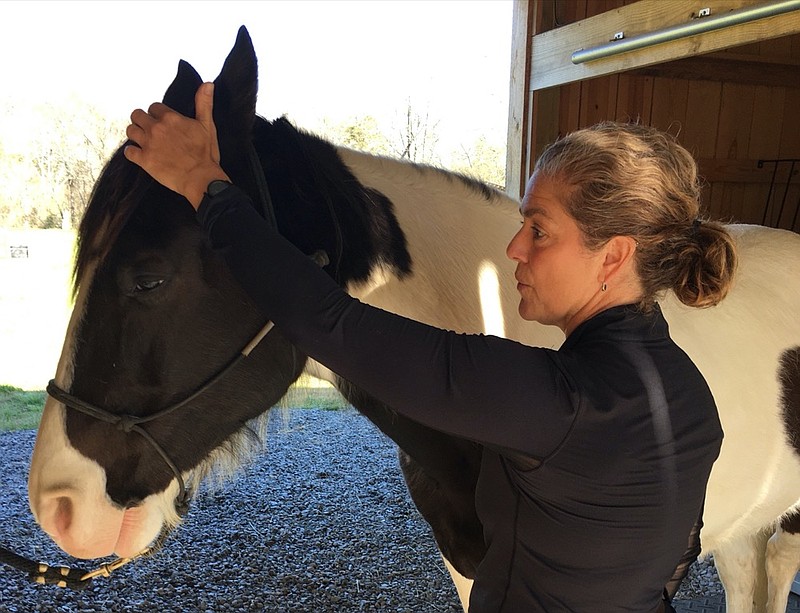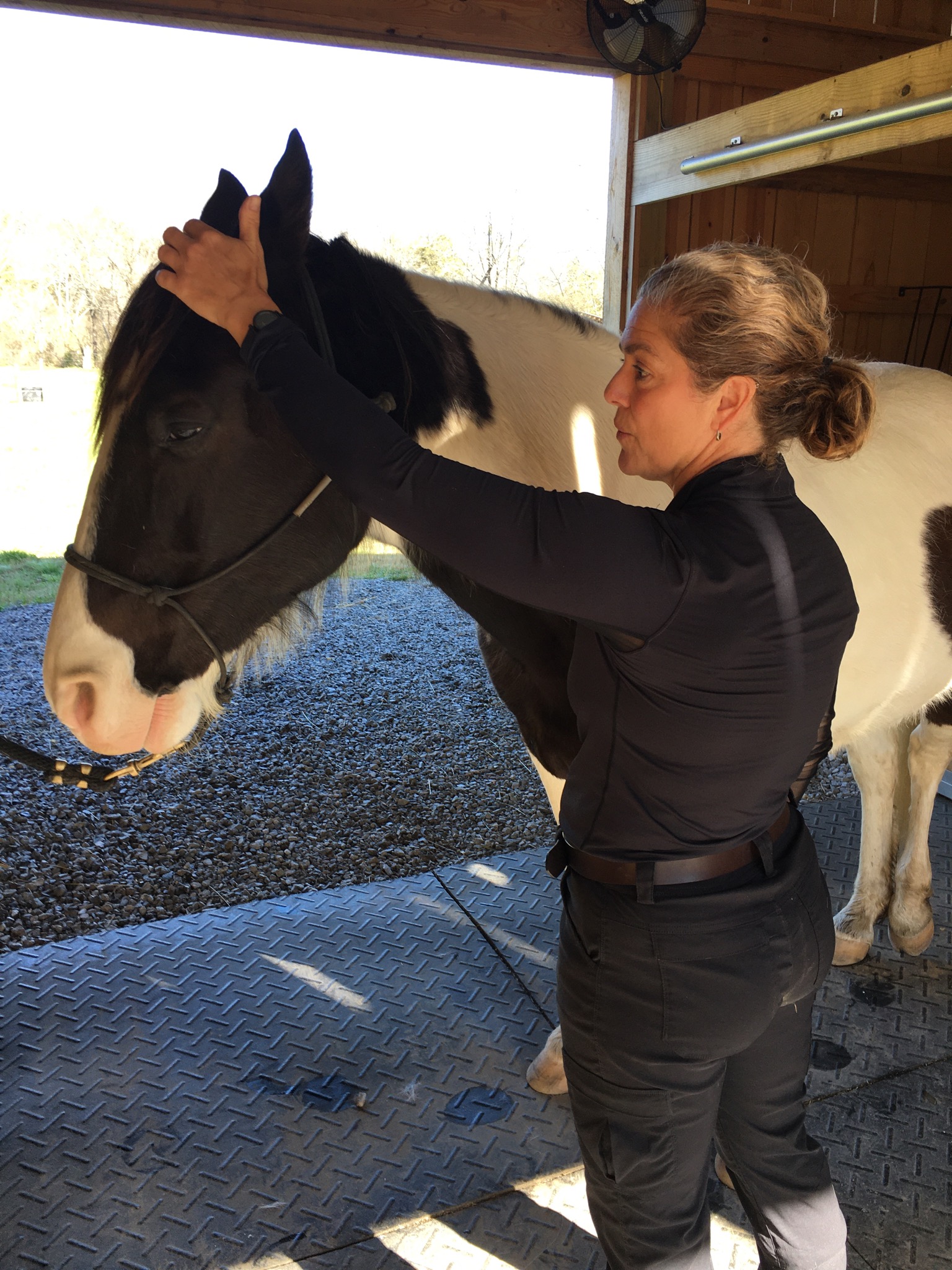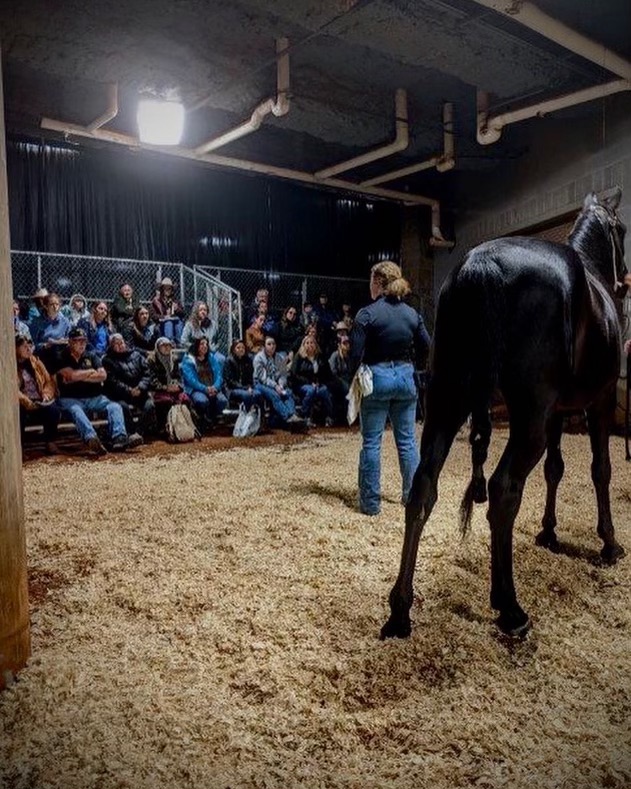When her partner's beloved trail horse, Lincoln, looked like he might need to retire at age 12 due to pain and sensitivity issues, Stephanie Wilkins knew she had to find a way to help.
"We had been having and doing chiropractic work on him, which we still believe in and do, but it just wasn't giving him full relief," Wilkins said. "He just wasn't comfortable in his body, and sometimes after only a few minutes on the trail, he would just stop dead in his tracks, like he couldn't go anymore."
Wilkins, of Flintstone, Georgia, is the former executive director of the Center for Mindful Living in Chattanooga. The mindful meditation company had to close its doors amid the COVID-19 pandemic, but out of that closure, Wilkins found a new calling working with animals for therapeutic benefit, and it was this new path and Lincoln's dire need that led her to the Masterson Method.
"I found a practitioner in Cohutta, Georgia, that did body work, and I called them to come work on Lincoln," she said. "The response was absolutely incredible; just two days later, we took him on the trail, and he was a completely different horse."
Where before Lincoln could only go a few minutes on the trail, Wilkins said now he walked as though he was on a cloud with freedom and purpose.
"He took off at a full gallop once he hit the woods," she said. "My partner looked at me with tears in his eyes and said, 'I've got my horse back.'"
From then on, Wilkins decided to make it her mission to learn and get certified as a Masterson Method provider so she could share and help as many horses and their owners as possible. Today, she's running a brand new business, High Point Equine Body Work, and working to help horses and owners connect across the South.
After an intense program that culminated a year and a half of training, clinics and one-on-one coaching, Wilkins is now trained and certified as a Masterson Method certified practitioner, Masterson Method equine specialist, coach and mentor and a certified therapeutic riding instructor with Professional Association of Therapeutic Horsemanship International.
Upcoming clinics
— 2-4 p.m. April 3 at Mending Arrow Ranch in Cleveland, Tenn. Equine Assisted Service Program, public demonstration.— 2-4 p.m. April 9 at Jessie’s Run in Harrison, public demonstration. Bring yourself and your horse.— 1-3 p.m. April 30 at Beginagin Farm in LaFayette, Ga., public demonstration.To learn more, visit bit.ly/hpbwequine or bit.ly/fbequine.
The Masterson Method, named for creator Jim Masteron in Fairfield, Iowa, focuses on practitioners applying various forms of pressure and then reading subtle cues from the horse to indicate where there's pain, restriction or tension that needs to be released.
"It can be something as simple as a lick or a chew, or more broad movements like a stretch or laying down to show a complete and full release," Wilkins said, noting that the key is to make sure "your touch is not too much."
Techniques used in the Masterson Method involve the lightest touches and pressures possible, ranging from an "air gap," where the hand of the person doing the work actually just hovers above the horse's body, not fully making contact but close enough for the horse to sense presence, to enough to indent an egg yolk, grape and a lemon, depending on the need and work being done.
"Horses feel so much more than we can as people, and they hold tension at certain junctions in their body," Wilkins said. "The techniques we use help ask the horse's nervous system to work by showing us where to troubleshoot and get them more into their 'brace' response, where we can identify the problem, and away from the typical fight or flight responses."
Owners don't need to wait until their horse presents with problems to take advantage of the benefits of this type of body work, either. Whether it's leisure horses for trail riding or work horses that are highly active or event competitors, regular body work, according to Wilkins, improves performance, connection and relationship between owner and horse, and it's something that when started early and done routinely, can bring about invaluable results.
Anne Zaharias, owner of Anne Zaharias Dressage, hired Wilkins to work with her team of dressage horses.
"There's definitely a positive energy to what she does," Zaharias said in a phone call. "She's really great at just gaining insight into horses that are sort of shy or have really big personalities and it's hard to get them to be vulnerable and show those soft spots and respond."
For those unfamiliar with dressage, Zaharias said it's something akin to ballet in human sports.
"The horses have to be really strong and subtle, and then we're asking them to coordinate these movements under us as a rider, and it brings a completely different element to it," she said. "What Stephanie does is help us make that channel a very peaceful, happy place and help us understand and find clear paths to put the puzzle together when the horse isn't feeling good in their environment."
Wilkins added that she enjoys showing owners how to do this for their horses.
"I love that this method is something you do with the horse, rather than to them," she said. "They become so in tune to you and the connection is so strong, and it can strongly decrease the risk for injury and performance issues down the line," she said.
Wilkins will travel anywhere there's a need for a horse and runs clinics and serves clients around Chattanooga and the north Georgia area, and some in Alabama. Her sessions range from an hour to an hour and a half for individual sessions, but they are always on "horse time."
"That means it can be shorter or longer depending on how the horse responds to the bodywork," Wilkins said. "I never want to rush or overstimulate them and always want to accurately and effectively be able to read their cues."
Contact Brandi Dixon at bdixon@timesfreepress.com or 423-757-6556.


